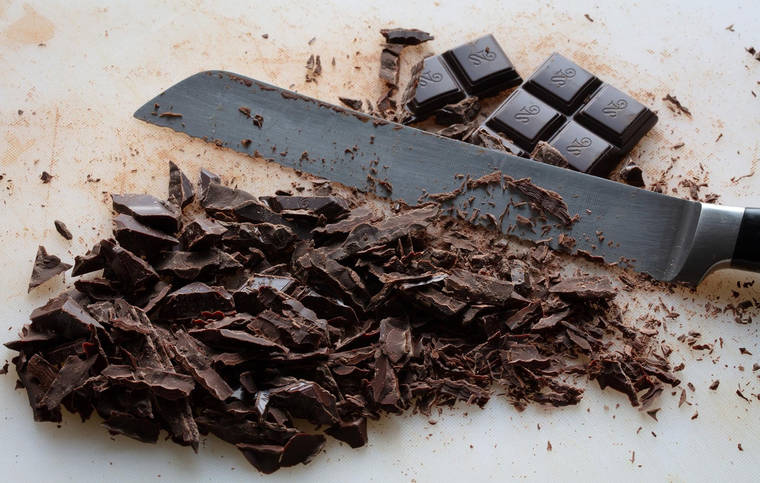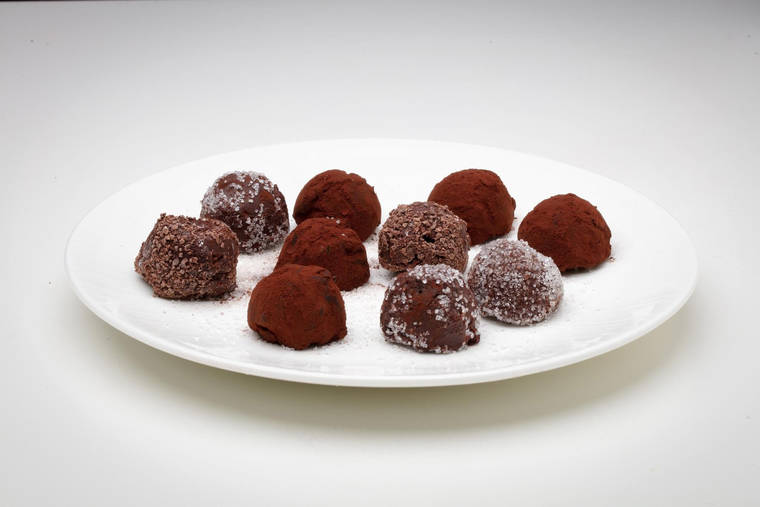Truffles are made from that wonderful brown goo the kids like to call “ganache.” Rhymes with “panache.” Ganache is chocolate melted with heavy cream. You’ve probably eaten ganache in a thousand cakes.
Or a billion truffles, because truffles are simply small balls of ganache. Sometimes they’re enhanced with bold flavors like espresso or booze, and usually they’re coated with something like crushed nuts or those little sprinkly things your mom would put on cookies. Because truffles can be messy, that coating prevents your hands from getting all chocolatey as you gorge yourself like a dingo in an abattoir.
Because of the truffle’s paucity of ingredients, my advice is to start with a bar of high quality dark chocolate, something in the 60% to 70% cacao range.
As for the cream, the thing you want to pay attention to is ratios. Ganache comes in different thicknesses, like lenses at the optometrist. For truffles, you want a fairly stiff ganache, roughly a 2 to 1 ratio of chocolate to cream. If you’re flavoring your truffles, figure about an ounce of booze or a teaspoon of extract per cup of cream.
To make ganache, bring your cream to a simmer in a small saucepan. While it heats, turn your chocolate bar into little shards: Using a serrated knife, such as a bread knife, shave off thin slices and the chocolate will crumble into bits like a desiccated mummy — just what you want. When you’ve got enough, give the chocolatey pile a few more chops to reduce the size of the pieces even further. Do this part with a chef’s knife, as you can rock its curved blade over the chocolate like you’re mincing garlic.
Next, grab a metal mixing bowl. Make sure it’s dry as a lunar plain, because water can make melting chocolate seize up like an oil-starved V6. Put your chocolate into the bowl and dump in the hot cream, letting it sit for several seconds to start the chocolate melting.
To combine the cream and chocolate, don’t use a whisk; use a rubber spatula. Stir in small circles from the inside out, working the chocolate into the cream to form a smooth and silky pond of delight. This is ganache.
Here’s a thing: It’s possible the diminishing heat from your cooling cream will not be enough to complete the meltification process. If that happens, make a bain marie: Bring about 2 inches of water to a boil in a saucepan, then reduce the heat to low. Place your bowl of creamy choco-lumps on top, taking care not to get any water into the bowl. (Should this happen and your chocolate seizes, mix in a little boiling water and it should turn liquid again.) Continue stirring over the steam until the aforementioned pond is achieved.
At this point, you have a decision to make: Melon baller or piping bag?
Shouldst thou go with the melon baller (what we with the fancy French culinary edumacation like to call a “Parisian scoop”), first use your spatula to scrape the ganache into a cake pan or casserole, something in which it can cool quickly. Place it in the fridge for an hour or two to firm up, then use your melon baller to scoop out individual portions and set them on a parchment-covered baking sheet. You could also use a plain old spoon, seeing as how a later stage involves hand-rolling each truffle anyway.
Or you could scrape the ganache into a piping bag and pipe out little brown blobs onto a parchment-covered baking sheet.
When you’re done, pop the pan into the fridge until your blobs are firm and ready to roll.
Oh, and in case you’re wondering how big to make your truffles, well, most truffles are in the half-ounce to 1-ounce range. I suggest piping (or scooping) out a couple blobs of different sizes, then using whichever one you prefer as your guide.
Whether your ganache is piped or scooped, now comes the rolling. Working quickly, place a blob between your palms and roll it into a spheroid shape. And listen: Be ye not concerned with perfection. Imperfection is a hallmark of artisanship, and proclaims with stentorian confidence, “I made these truffles with my own two hands!”
By the way, the reason I said to work quickly is because as the unrolled truffles sit out, they warm up. Also, you don’t want the truffles to stay in your hands any longer than necessary because they’ll start to melt. But, look, don’t kid yourself: Chocolate is messy, and by the time you’re done your hands will remind you of those halcyon days spent mud wrestling out back of the tavern. Still, the faster you roll, the cleaner you’ll stay. You could always pop the ganache back in the fridge to chill if things get too warm.
Once all your truffles look like tiny brown moons, roll them in something dry, like powdered sugar, cocoa powder, coconut flakes, crushed nuts, etc. You could also dip them in melted chocolate, but, that will be a longer lesson for another day. Store them in the fridge for up to a week, or, before you do that, you could just see how many you can cram into your piehole all at once.
Chocolate truffles
Prep: 30 minutes
Chill: 30 to 60 minutes
Makes: 45 truffles
1 pound block good bittersweet or semi-sweet chocolate, 60% or higher cacao
8 ounces heavy cream
1 ounce softened butter
1 teaspoon vanilla extract
Dutch-processed cocoa powder, crushed nuts, powdered sugar, sprinkles or other coating ingredients
Using a serrated knife, shave chocolate into thin slices, then mince the pile of shavings to make very small pieces. Scrape chocolate into a clean, dry, stainless steel bowl.
Heat cream to simmering, then pour over chocolate. Stir in a tight circle from center of bowl, gradually working in cream from edges to form an emulsion. This is your ganache. (Note: If your chocolate doesn’t melt all the way, place the bowl over a bain marie — a saucepan in which a couple inches of water is simmering. Keep the flame turned low and take care not to get any water in the ganache while you continue stirring until the chocolate is completely melted.)
When the cream is fully incorporated and the chocolate ganache is smooth and creamy, stir in butter and vanilla until incorporated.
To form truffles, there are two common methods, which we’ll call Method A and Method B:
Method A: Pipe small ganache pyramids onto a parchment-covered baking sheet. Refrigerate until firm, about 30 minutes, then roll each piece between your palms to form a sphere.
Method B: Refrigerate all the ganache in the mixing bowl or in a flatter container (for faster chilling), until firm, 30 to 60 minutes. Using a melon baller, carve out spheres of chocolate and place them on a parchment-lined baking sheet. Do not obsess over the perfection or lack thereof of your ganache balls. When the baking sheet is full, roll each ball between your palms to achieve a more spherical shape.
Place cocoa powder, nuts, powdered sugar or some other coating ingredient into a bowl. Roll each truffle in coating, then return to baking sheet. Refrigerate up to 2 weeks, as if they’ll last longer than a couple days.


